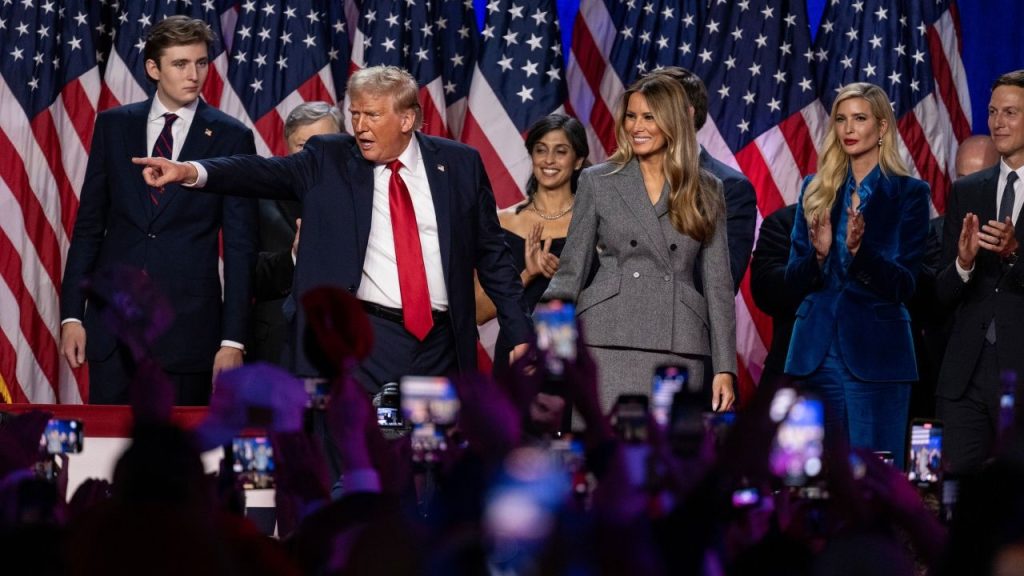Trump’s master plan for a radical reformation of the US government
4 min read
President-elect Donald Trump points to the crowd at his election watch party in West Palm Beach, Florida, on November 6. Will Lanzoni/CNN

President-elect Donald Trump points to the crowd at his election watch party in West Palm Beach, Florida, on November 6. Will Lanzoni/CNN
President-elect Donald Trump has laid out an ambitious agenda for his second term, one that would radically reshape the U.S. government and the country’s approach to policy. His proposed changes, spanning immigration, taxes, government structure, and foreign policy, promise to be transformative. While some of these proposals appear feasible, others may face significant legal and political hurdles. Here’s a look at some of the key aspects of Trump’s master plan.
Mass Deportations and Border Control
One of Trump’s most aggressive promises is the mass deportation of undocumented immigrants. He has made it clear that on Day 1 of his presidency, he plans to reinstate harsh border policies rolled back by the Biden administration. Trump’s advisor, Stephen Miller, has said deportations will begin immediately upon his inauguration, with a focus on criminal immigrants. However, the logistics of deporting millions of people remain unclear. Rep. Carlos Gimenez of Florida has suggested that each deportation case will be heard before a judge, which would require a significant increase in government personnel.
The scope of the border policies is also uncertain. While Trump has vowed to close the southern border and end birthright citizenship, the legal complexities of these proposals, particularly around the 14th Amendment, could spark lengthy court battles. The use of military, National Guard, or local law enforcement to enforce these policies is still a topic of debate.
A New Approach to Government Spending and Civil Service
Another core aspect of Trump’s plan involves overhauling the federal bureaucracy. In his first term, Trump initiated the controversial “Schedule F” plan, which aimed to strip protections from civil servants and make it easier to fire federal employees. While the Biden administration has blocked these efforts, Trump has promised to reinstate them and eliminate what he deems “rogue bureaucrats” from government positions. He has also vowed to “clean out” corrupt actors in the national security and intelligence agencies.
Trump’s vision includes relocating key federal agencies out of Washington, D.C., a move designed to decentralize power and reduce the influence of the federal establishment. The success of these initiatives depends on Trump’s ability to push through significant changes to the civil service structure, which would likely face legal challenges.
Economic and Tax Reforms
Trump has proposed sweeping tax cuts, with a focus on benefiting corporations, seniors on Social Security, and property owners, particularly in the Northeast. He has also pledged to implement unprecedented tariffs on foreign goods, especially from China. The economic implications of these policies could be far-reaching, with potential trade wars and shifts in global supply chains.
Additionally, Trump has promised massive cuts in government spending, with backing from high-profile figures like Elon Musk. This could involve reductions in social programs and government services, but specifics remain vague. If enacted, these policies would radically reshape the U.S. economy and impact millions of Americans.
Reforming Healthcare and Food Systems
Trump has indicated a desire to reform the country’s healthcare and food systems, including bringing in figures like vaccine skeptic Robert F. Kennedy Jr. to help shape policy. The details of these reforms are still unclear, but Trump’s previous attempts to repeal the Affordable Care Act signal that healthcare will be a central issue in his second term.
Military and Defense Initiatives
On the military front, Trump has promised to build a new missile defense shield. He has floated the idea of involving former NFL player Herschel Walker in this effort, though it is unclear whether Walker will take on a formal role. Trump’s military strategy is part of a broader goal to strengthen U.S. defense capabilities and challenge adversaries like China and Russia.
Cabinet and Personnel Changes
Trump’s Cabinet will likely see major changes, with a focus on loyalty over experience. He has already announced Susie Wiles as his chief of staff, making her the first woman to hold the position. His administration will likely feature a mix of former Trump loyalists, some of whom worked on Project 2025, a detailed blueprint for restructuring the government published by conservative groups.
Challenges to Congressional Authority
One of Trump’s more contentious proposals is to challenge the current balance of power between the executive and legislative branches. He has pledged to assert the principle of “impoundment,” which would allow the president to reject spending instructions from Congress and redirect taxpayer money as he sees fit. This is a direct challenge to the limitations placed on presidential power following the Nixon administration and could lead to significant constitutional confrontations.
Conclusion
While many of Trump’s proposals are ambitious, they face numerous challenges, from legal battles to resistance within Congress. The practicality of mass deportations, large-scale spending cuts, and executive actions aimed at reshaping the federal workforce will be tested in the coming months. If enacted, Trump’s vision would mark a dramatic departure from traditional governance, but its success will depend on the ability to navigate legal, political, and logistical hurdles. As the country braces for a new era, Trump’s second term promises to be a period of deep political and societal transformation.